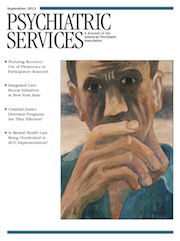This Month’s Highlights
Picturing Recovery
The recovery model is a major force shaping services, research, and policy. The main tenet is that people can overcome the often shattering consequences of serious mental illness and create fulfilling lives. Conceptual frameworks of recovery have been detailed, and researchers sometimes argue over definitional nuances. But what does recovery actually look like? This month’s lead article presents some photographs. The pictures were taken by participants in a study using photovoice, a research approach in which a group of people use cameras to document their daily realities and create narratives about them to promote dialog and inform social action. The study, which was conducted by Leopoldo J. Cabassa, Ph.D., and colleagues at two supported housing agencies in New York City, recruited people with serious mental illness and a history of substance abuse and homelessness. Over six weeks, photovoice groups came together for 90-minute sessions to present and discuss photographs they had taken to document what recovery meant to them. When the groups ended, the authors used a number of analytic techniques to tease out recovery themes. Being able to provide support to others was one. An online appendix presents two pictures and accompanying narratives (page Original article: 837).
Making Integrated Care Happen
The importance of integrating care is a recurring theme in this month’s issue. The second contribution to the journal’s new Integrated Care column describes recent policy and program initiatives undertaken by the New York State Office of Mental Health (OMH) to enhance integration of general medical and behavioral health care. Calling integrated care “the new gold standard,” Thomas E. Smith, M.D., and colleagues underscore OMH’s operating perspective: “What gets measured gets managed.” Among the initiatives they describe is a Web-based clinical decision support tool that helps behavioral health providers monitor health indicators among adults and children in mental health clinics. They also describe a partnership to train primary care providers to screen for depression and make appropriate referrals, the creation under Medicaid managed care of a state network of patient “health homes,” and efforts to track provider performance (page Original article: 828). This month’s Open Forum takes a closer look at the accountable care organization (ACO), a model for organizing providers across multiple care settings to deliver collaborative, patient-centered prevention and treatment services. Donovan T. Maust, M.D., and colleagues detail various approaches to implementing ACOs that are being promoted by the Centers for Medicare and Medicaid Services and that could improve care for people with serious mental illness. However, these authors also show how ACO implementation might overlook these high-cost, high-risk patients (page Original article: 908). In this month’s Taking Issue, Andres Barkil-Oteo, M.D., M.Sc., argues that integrating psychiatry into the primary care sector is not an option but a necessity and that psychiatrists bear a responsibility for mental health services that are currently being delivered by nonpsychiatrists (page Original article: 825).
Improving Criminal Justice Outcomes
Three studies examine outcomes for people with mental illness who become involved in the criminal justice system. Communities in the United States and elsewhere have developed criminal justice liaison and diversion (CJLD) services, such as mental health courts, to identify offenders with mental disorders and link them to appropriate community services. To investigate the effectiveness of CJLD services, David A. Scott, Ph.D., and colleagues synthesized findings from a literature review that included only studies designed with a comparator group. Data showed that CJLD services appear effective and have positive impacts on outcomes. However, important findings were the marked lack of rigorous studies and the absence of a national policy framework to guide development of CJLD service models (page Original article: 843). Researchers in Finland designed a controlled trial to reduce seclusion and restraint under challenging conditions. Anu Putkonen, M.D., Ph.D., and colleagues undertook the trial at a high-security hospital that serves as a last resort for criminal and civil patients with psychotic disorders and a history of violence. Staff on the two intervention wards received intensive training and supervision in applying core reduction strategies, whereas staff on the two control wards did not. Analyses of incidence data showed that seclusion and restraint were prevented without an increase in violence (page Original article: 850). An examination of 2005–2012 data for more than 4,000 Florida Medicaid enrollees with serious mental illness found that possession of psychotropic medication and receipt of outpatient services reduced the likelihood of being arrested. Richard A. Van Dorn, Ph.D., and colleagues also found that possessing medication for the 90 days after a hospital stay conferred additional protection (page Original article: 856).



